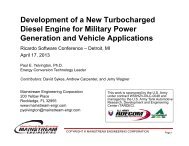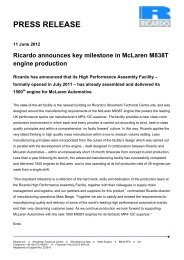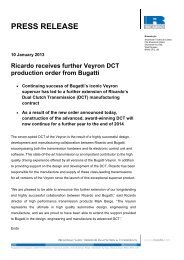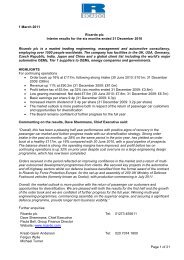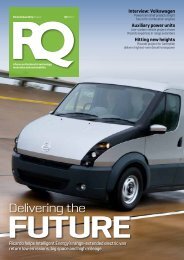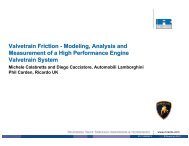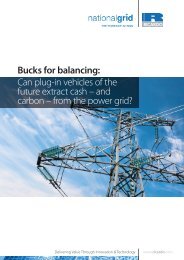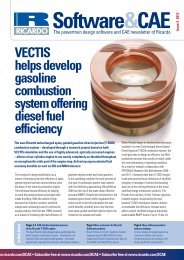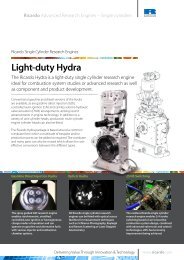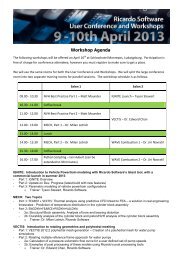The hottest - Ricardo
The hottest - Ricardo
The hottest - Ricardo
Create successful ePaper yourself
Turn your PDF publications into a flip-book with our unique Google optimized e-Paper software.
percent of the entire global market,<br />
with more likely to follow. All the more<br />
remarkable is the fact that the Split<br />
Carburettor concept costs virtually<br />
nothing extra to manufacture since it<br />
essentially comprises a modification<br />
to an existing design, yet is set to save<br />
two-stroke engine manufacturers<br />
world-wide hundreds of millions of<br />
Dollars.<br />
Two-stroke engines have many<br />
advantages over four-strokes in some<br />
applications, including low weight,<br />
simplicity, high power output and<br />
typically 25 per cent lower<br />
manufacturing costs. In fact, as group<br />
head Paul Etheridge explains, when it<br />
comes to hand-held utility products,<br />
conventional four-stroke engines have<br />
definite limitations. “Hand-held<br />
products have to work in any altitude<br />
but if you turn a wet sump lubricated<br />
four-stroke engine upside down, the<br />
oil disappears into the cylinder head.<br />
Response and torque backup are<br />
inferior to the two-stroke, they’re<br />
heavier and they cost more money to<br />
make. In fact there is a huge raft of<br />
issues with the four-stroke.”<br />
Two-strokes: environmentally<br />
poor – until now<br />
Unfortunately, when it comes to<br />
exhaust emissions (in standard form<br />
at least) the unregulated two-stroke<br />
engine is something of an<br />
environmental bandit. Each time it<br />
ingests a fresh charge of fuel, some of<br />
it is expelled with the outgoing<br />
exhaust: this results in a level of<br />
unburned hydrocarbons which makes<br />
a puff of modern car exhaust appear<br />
like a breath of fresh Alpine air. “About<br />
30 per cent of the fuel you put into a<br />
conventional two-stroke engine<br />
passes straight through without even<br />
being burned,” Etheridge continues,<br />
“so you get around 10 times the<br />
hydrocarbon emissions of a fourstroke.”<br />
Catalytic converters have been<br />
tried but proved unsuccessful in many<br />
products because of their not<br />
insignificant cost, bulk and also<br />
because the high temperatures they<br />
generate could injure operators and<br />
cause fires.<br />
Not surprisingly, legislators are<br />
clamping down on these engines. If<br />
manufacturers want to use two-stroke<br />
power beyond 2008-2010 they will be<br />
forced to think again in order to meet<br />
stringent US and European emissions<br />
regulations aimed specifically at handheld<br />
utility engines. <strong>The</strong> most popular<br />
way of achieving that is to use a new<br />
design of two-stroke known as the airhead<br />
stratified charge engine, which<br />
introduces what is in effect an air wall<br />
immediately in front of each incoming<br />
charge of fuel and air. As a result, any<br />
Q2, 2006 • RICARDO QUARTERLY REVIEW 15



